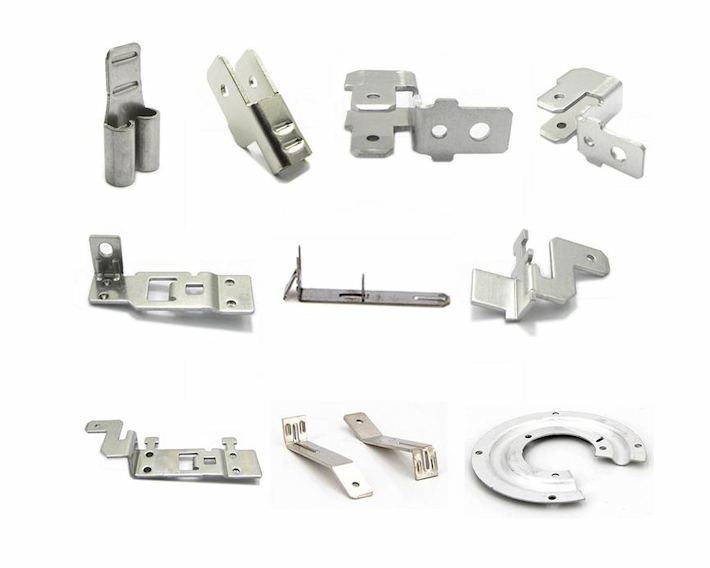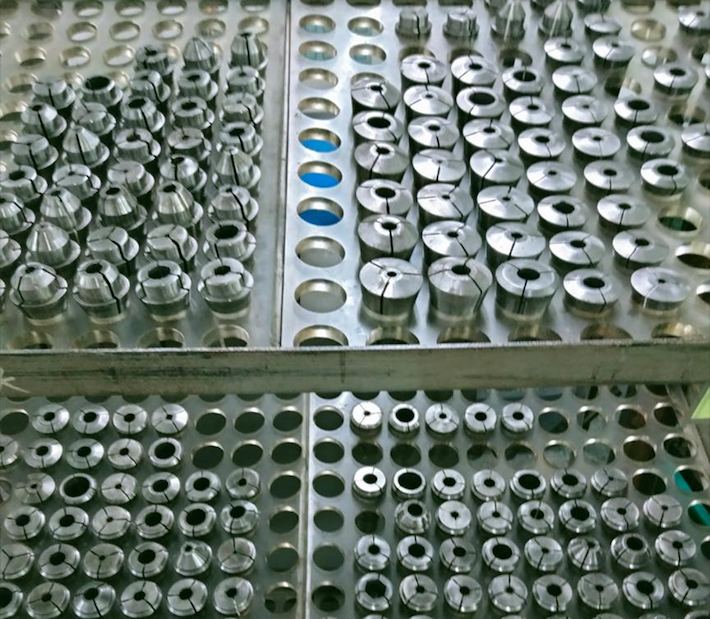
تتضمن مراقبة الجودة لأجزاء الختم تدابير وعمليات مختلفة لضمان تلبية المكونات للمواصفات والمعايير المطلوبة. ويشمل ذلك استخدام أدوات الفحص المتقدمة ، وإجراء عمليات الفحص البصري ، وإجراء عمليات التحقق من الأبعاد ، وإجراء اختبارات الأداء. من خلال مراقبة صارمة للجودة ، يمكن التحقق من ختم الأجزاء لتلبية متطلبات العملاء ، وتحسين جودة المنتج ، وتقليل العيوب ، مما يؤدي في نهاية المطاف إلى ارتفاع رضا العملاء وأداء أعمال أفضل.
تتميز طوابع الفولاذ المقاوم للصدأ بدقة HHC بقوتها الفائقة ومتانتها ومقاومتها للتآكل. يمكن لعمليات الختم المتقدمة إنتاج أشكال وتصميمات معقدة لتلبية احتياجات مختلف الصناعات مثل السيارات والطيران والإلكترونيات والطبية وتجهيز الأغذية. ميزات ختم أجزاء اللكم تشمل:
قوة ومتانة عالية:مناسبة للأحمال العالية والبيئات القاسية.
مقاومة ممتازة للتآكل:يقاوم الرطوبة والمواد الكيميائية ودرجات الحرارة العالية.
تصنيع الدقة:تلبية احتياجات عملائنا المخصصة ، وضمان الجودة العالية وفعالية التكلفة.
يوفر استخدام أجزاء الختم في التصنيع العديد من الفوائد ، بما في ذلك كفاءة الإنتاج العالية وفعالية التكلفة والدقة. يمكن إنتاج أجزاء الختم بكميات كبيرة بأقل قدر من النفايات ، مما يؤدي إلى انخفاض تكاليف الإنتاج. كما أنها دقيقة للغاية ، مما يسمح بجودة ثابتة وأداء محسن للمنتج. بالإضافة إلى ذلك ، فإن أجزاء الختم متعددة الاستخدامات ويمكن تخصيصها لتلبية متطلبات التصميم المحددة ، مما يجعلها مناسبة لمجموعة واسعة من التطبيقات في مختلف الصناعات.
جدول تسليم صارم: يتم ضمان الالتزام الصارم بجداول التسليم. بالنسبة للسلع المخزنة ، يتم إرسال الطلبات على الفور عند الاستلام ، مع خيارات للشحن البحري أو البري أو الجوي. بالنسبة للمنتجات المخصصة ، تضمن عمليات التصميم إلى التصنيع المتكاملة التسليم السريع في غضون 1-4 أسابيع.
ضمان الجودة: نظام فحص منتظم للجودة وآلات تعمل على مدار 24 ساعة اختبار ذكي يضمن جودة المنتج طوال عملية التصنيع.
عمليات الإنتاج الفعالة: تتميز عمليات الإنتاج لدينا بكفاءة عالية ، وتشمل الختم ، وتصنيع الآلات باستخدام الحاسب الآلي ، ومراكز المعالجة ، والتمدد ، والطلاء بالكهرباء ، والتخليل ، والتخميل ، والتنظيف ، والطحن ، والتجميع ، وأكثر من ذلك. تمكننا هذه العمليات من تقديم خدمات عالية الجودة ومنتجات تنافسية.
المخضرم المحترم في تصنيع الأجهزة: مع أكثر من 23 عامًا من الخبرة وورشة إنتاج تمتد على مساحة أمتار مربعة ، أنشأنا شركة رائدة موثوق بها في هذه الصناعة ، وتباهى بحديقة صناعية خاصة بنا.
في عالم تصنيع المعادن ، تلعب عمليتان شائعتان ، الختم واللكم ، أدوارًا حاسمة في تشكيل المواد لمختلف التطبيقات. في حين أنها تشترك في أوجه التشابه ، فإن فهم الاختلافات الرئيسية بين الختم واللكم أمر ضروري للمصنعين والمهندسين. تتعمق هذه المقالة في الفروق الدقيقة التي تفصل هذه العمليات ، وتوفر نظرة ثاقبة حول وقت استخدام كل طريقة للحصول على أفضل النتائج.
ختم:
يتضمن الختم استخدام قالب لتشكيل وتشكيل صفائح أو شرائح معدنية. يحتوي القالب ، المصنوع عادة من الفولاذ الصلب ، على النمط أو التصميم المطلوب. الضغط ينطبق القوة على المادة ، مما يجعلها تأخذ شكل القالب. تُستخدم هذه العملية بشكل شائع لإنشاء أشكال أو أنماط أو شعارات معقدة على الصفائح المعدنية.
اللكم:
اللكم ، من ناحية أخرى ، ينطوي على إزالة جزء من المادة لإنشاء ثقب أو فتحة. يتم استخدام مجموعة لكمة وتموت ، مع لكمة دفع طريقها من خلال المواد لإنشاء ثقب أو الشكل المطلوب. اللكم فعال بشكل خاص لإنتاج ثقوب بسيطة ومتسقة في المكونات المعدنية المختلفة.
ختم:
يُفضل الختم للتطبيقات التي تتطلب تصميمات أو أنماط أو ميزات منقوشة معقدة. يستخدم عادة في صناعات مثل السيارات والإلكترونيات وتصنيع الأجهزة لأغراض الديكور أو وظيفية.

اللكم:
يعد الثقب مناسبًا تمامًا للتطبيقات التي تحتاج إلى ثقوب بسيطة ومتسقة ، كما هو الحال في إنشاء الأقواس أو الألواح أو المكونات التي تتطلب فتحات موحدة. يستخدم على نطاق واسع في صناعات مثل البناء ، وتصنيع المعادن ، والتكييف.

بينما يشترك الختم واللكم في أرضية مشتركة في مجال تصنيع المعادن ، يكمن التمييز في تطبيقاتها المحددة والنتائج التي تحققها. ختم تتفوق في إنتاج تصاميم وأنماط معقدة في حين اللكم هو الأسلوب المفضل لخلق ثقوب دقيقة.
HHC (Haohaichang) تقدم مجموعة من خيارات الطلب لتلبية احتياجات العملاء المتنوعة. من النماذج الأولية المخصصة إلى الإنتاج الصغير والمتوسط والواسع النطاق ، توفر HHC التعاون من طرف إلى طرف. تعد HHC خدمات تكامل سلسة من التحقق من صحة العينة إلى الإنتاج الضخم.

1. نماذج عينة مخصصة:
تدرك HHC أهمية تطوير النموذج الأولي في عملية تصميم المنتج والتحقق من صحته. مع تركيز مخصص على تلبية مواصفات العميل ، تقدم HHC خدمات نماذج أولية مخصصة. تتيح هذه المرحلة للعملاء تقييم جدوى مكوناتهم وتصميمها ووظائفها قبل الالتزام بكميات إنتاج أكبر.
2. طلبات دفعات صغيرة:
للمشاريع التي تتطلب كميات محدودة ، تستوعب HHC طلبات دفعات صغيرة بدقة وكفاءة. تعتبر طلبات الدفعات الصغيرة مثالية للاختبار الأولي للسوق ، مما يضمن قدرة العملاء على تقديم منتجاتهم بأقل قدر من المخاطر والجودة المثلى.
3. أوامر دفعة متوسطة:
مع توسع الشركات ، تنشأ الحاجة إلى طلبات دفعات متوسطة. تحولات HHC بسلاسة من أحجام الإنتاج الصغيرة إلى المتوسطة ، مما يوفر نفس مستوى الاهتمام بالتفاصيل وضمان الجودة. تلبي هذه المرونة متطلبات العملاء المتطورة في مختلف الصناعات.
4. طلبات دفعات كبيرة:
تمتد قدرات HHC إلى الإنتاج على نطاق واسع ، وتقديم الطعام للعملاء ذوي متطلبات الحجم الكبير. من خلال الاستفادة من التكنولوجيا المتقدمة وعملية الإنتاج المبسطة ، تضمن HHC التسليم الفعال وفي الوقت المناسب لطلبات الدفعات الكبيرة دون المساس بالجودة.
التزام HHC بمرونة الطلب يميزها في عالم تصنيع المعادن. من النماذج الأولية المخصصة للعينات إلى أحجام إنتاج ختم OEM واسعة النطاق ، توفر HHC مجموعة سلسة وشاملة من الخدمات. يمكن للعملاء الوثوق في HC للتنقل في كل مرحلة من مراحل عملية الإنتاج ، مما يضمن تلبية احتياجاتهم الفريدة بدقة وكفاءة.
ختم المعدن ، المعروف أيضًا باسم الضغط ، هو عملية تشكيل صفائح أو شرائح معدنية إلى الأشكال والتشكيلات المطلوبة باستخدام مكبس ختم وقوالب. تتضمن عملية التصنيع هذه الضغط على قطعة العمل المعدنية ، مما يؤدي إلى تشوهها أو إبدتها ، وبالتالي إنشاء الشكل أو النمط المطلوب. تتضمن عملية ختم HHC تقنيات مثل القطع واللكم والانحناء والتمدد والنقش.
عندما يتعذر على عملية ختم واحدة تحقيق الشكل المطلوب أو عندما يكون شكل قطعة العمل معقدًا للغاية ، فإننا نستخدم ختم القالب التدريجي. ضمن مجموعة قالب واحد ، تم تجهيز كل محطة بواحدة أو عدة عمليات ختم أساسية لإكمال معالجة جزء معين من قطعة العمل المختمه. وهذا ينطوي على سلسلة مستمرة من العمليات بما في ذلك القطع والانحناء واللكم والضغط والتشكيل.
نحن مقرها في شنتشن ولدينا حديقة صناعية خاصة بنا في هويتشو. مع 23 عامًا من الخبرة في مجال تصنيع الأجهزة ، قمنا ببناء فريق من الخبراء الفنيين المكرسين للتحسين المستمر وفريق من المديرين ذوي الخبرة. بفضل المعدات المتطورة والدعم المؤسسي ، تستطيع HHC الاستفادة من خبرتها في التصميم والتصنيع في صناعة الأجهزة مع ضمان منتجات وخدمات عالية الجودة وتحقيق أرباح معقولة. لذلك ، نحن واثقون من مواجهة المخاطر في أي وقت. نرحب بكم لزيارة شركتنا للتفتيش. مبنى A1 ، حديقة رونغتشانغ الصناعية ، منطقة هيدونغ رقم 440 ، هينجكنج ، جوانلان ، حي لونغهوا ، مدينة شنتشن ، مقاطعة قوانغدونغ ، الصين
تنتج HHC مجموعة واسعة من الأجزاء ذات الختم ، بما في ذلك نوع التمدد ، نوع الحافة ، نوع القوس الصغير ، نوع المحطة الطرفية من الأسلاك ، نوع التثبيت ، نوع الصفيحة الزنبركية ، موصل من النوع الطرفي ، ومنتجات من نوع القطعة الطرفية. تستخدم هذه الأجهزة على نطاق واسع في مكونات الأجهزة المنزلية ومكونات السيارات وصناعات تخزين الطاقة الجديدة ومكونات الإلكترونيات الاستهلاكية والطائرات الصغيرة ورادار الاتصالات والصناعة الطبية.
يتضمن تحديد أفضل المواد للمنتجات ذات الطابع المختتم النظر في عوامل مثل المتطلبات الوظيفية وخصائص المواد وبيئة التشغيل والتكلفة. على سبيل المثال ، تستخدم سبائك الألومنيوم 7075-T6 بشكل شائع في أنظمة تعليق المركبات ، بينما يستخدم الفولاذ 45 # في كثير من الأحيان في أنظمة نقل نقل المركبات ، وكثيرا ما يستخدم الفولاذ المقاوم للصدأ لقياسات أنابيب العادم. يستخدم النحاس C26000 بشكل شائع في مشعات السيارات ، وغالبا ما توجد سبائك النحاس والنيكل C70600 في أنظمة الكبح ، من بين أمور أخرى. سنقدم أفضل توصيات الحلول بناءً على الشروط المحددة لتطبيق العميل.


